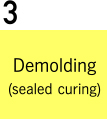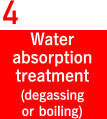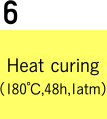Development of PFC(Pore Free Concrete/Porosity Free Concrete)
with highest strength in the world
| >Introduction | >Development of PFC | >Special features of PFC | >Expanding applications |
Development concept
 Concrete is a porous material with voids in its structure, but it is known that making the diameter of these voids smaller improves the strength, and reducing the amount of voids increases the strength exponentially. (for example, Powers (1948))
Concrete is a porous material with voids in its structure, but it is known that making the diameter of these voids smaller improves the strength, and reducing the amount of voids increases the strength exponentially. (for example, Powers (1948))
 Because just mixed concrete has flow properties, casting it into a formwork allows the designer to create the shape of their choice. We attempted to achieve the highest strength in the world without sacrificing this traditional advantage of concrete.
Because just mixed concrete has flow properties, casting it into a formwork allows the designer to create the shape of their choice. We attempted to achieve the highest strength in the world without sacrificing this traditional advantage of concrete.
Material design… Creating a close-packed mix
 Ordinary high strength concrete is made by adding the ultrafine powder material silica fume to cement to increase the filling properties of bonding materials. But because there is a 100 times difference in the particle diameter of cement and silica fume, we found that there still existed voids between powder particles. Therefore, we aimed to create extremely fine powder by adding particles with a size intermediate between cement and silica fume. By adopting this third material intermediate particle, we calculated the close-packed state with the smallest void between powder particles by a numerical simulation, and discovered the formula of the optimal bonding material.
Ordinary high strength concrete is made by adding the ultrafine powder material silica fume to cement to increase the filling properties of bonding materials. But because there is a 100 times difference in the particle diameter of cement and silica fume, we found that there still existed voids between powder particles. Therefore, we aimed to create extremely fine powder by adding particles with a size intermediate between cement and silica fume. By adopting this third material intermediate particle, we calculated the close-packed state with the smallest void between powder particles by a numerical simulation, and discovered the formula of the optimal bonding material.
We created the close-packed (smallest gaps in powder mixture) mix
by adopting a new material previously unused in the concrete domain.
Manufacturing method… Supplying reaction water by water absorption treatment

PFC material can be mixed with the same mixer conventionally used.

Mixed PFC has adequate flow properties to be cast into a formwork.

Remove the formwork after the PFC has hardened.

Reaction water is supplied to the PFC interior by water absorption treatment.

High-temperature steam curing is performed, encouraging hydration reactions.

Additionally, heat curing is performed in dry conditions, expelling excess moisture to the exterior.

Because bonding materials of ultra-high strength concrete are mixed with extremely little water content, there is not sufficient moisture for the hydration reaction of cement. Therefore, the lacking reaction water is forcibly supplied from the exterior by performing 30 minutes of water treatment on the 1 to 2-day old concrete. There are two water absorption methods, degassing and boiling. Following the water absorption treatment, two-stage thermal curing (steam curing and heat curing) is performed to encourage hydration with the supply water and form an ultra-fine, hardened structure.
